Kayak Safety Tips: Everything You Need To Know About Safe Kayaking
- By: Joseph Simonds
- on
- Found In: Fishing Tips, Kayak Fishing

Nothing ruins a fun kayak trip like an unexpected accident or potential hazard…
And if you go kayaking enough, you will encounter the unexpected.
Accidents (like these below) will eventually happen to just about any kayak angler at some point:
- Lightning storm that comes out of nowhere while you are out in your kayak
- Cuts on your hands
- A hook getting stuck in your body
- Flipping over while standing up
- Snake falling in your kayak from the trees
- Hooking into a monster fish that flips you over
So we wanted to put together the ultimate safety guide for kayakers so that you can anticipate and prepare for anything.
Enjoy these kayak safety tips and be safe out there!
Related Post: 5 Things Anglers Regret Not Knowing When They First Start Kayak Fishing (see it here now)
The Ultimate Guide To Kayak Safety
by Tony Acevedo

Note: these kayak safety tips are in no specific order, and I encourage you to read through all of them to make sure you are as safe as possible while out on your kayak.
Kayak Lights
Being seen at night and during low light conditions (such as rain, fog, etc.) is highly important for your safety in a kayak.
I have heard of kayakers getting hit by boats and this can usually be avoided if you have the proper kayak lighting.
Also, it is very important NOT to add any unnecessary lighting that can confuse vessels in navigation (as it could result in a collision). Be sure to always check your state’s local requirements for kayaks, or unpowered vessels under a certain length.
First, let me define some terms so you know which lighting regulations apply to you:
- Unpowered Vessel: Sailboats or vessels that are paddled, poled, or rowed.
- Power Driven Vessels: Vessels operating under engine power
- Underway: Vessels in motion
- Not Underway: Vessels anchored, moored, or stationary
In Florida, unpowered vessels less than 23 ft in length that are underway are not required to have red/green navigations lights.
Putting red/green navigation lights on your kayak can actually do more harm than good.
Why?
Because kayaks are not capable of moving out of the way of a power-driven vessel.
By displaying these red/green lights, other vessels may be unaware that you are a kayak or paddle craft and may expect you to get out of the way which can result in a collision.
As long as you properly display an all around white light (which is mentioned in the next paragraph), vessels are required to give you adequate space. Note that this doesn’t mean you can anchor in the middle of a channel and just expect them to go around you, as it is illegal to anchor in any navigational channel.
All vessels (including kayaks) are required to have a USCG Approved All Around White Light When Not Underway, from sunset to sunrise or during periods of limited visibility (rain, fog, etc.)
These lights must be visible from at least 2 miles away on a dark, clear night (which gives them the USCG approval).
When you are moving, it is highly recommended to keep this light on and visible.
A bright LED headlamp or flashlight is also a great item to have as an extra means of being visible to other boaters.
The biggest mistake many kayakers make is creating their own DIY all around white light for when they are anchored.
This MUST be a USCG approved light when you are anchored and cannot be some type of glow stick or flashlight attached to a pvc pipe. These can be used, however, when underway to display in time to avoid a collision.
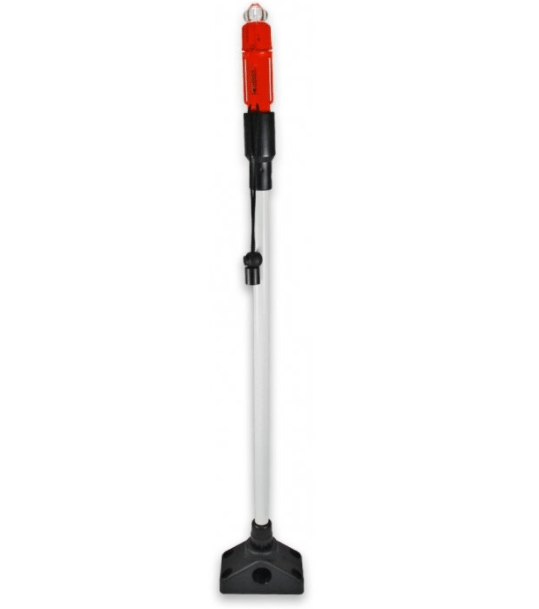
Are you making one of these six mistakes when it comes to inshore fishing from your kayak?
Click here to take the 60-second Kayak Skunk Factor Survey and find out.
Visual Distress Signals (VDS)
In addition to the required lighting above, when operating your kayak at night on coastal waters (between sunset and sunrise) you are required to have at least three night signals.

These can be a combination of Red Flares, Red Meteors, and an Electric Light.
Note that the flares and meteors may have expiration dates on them so make sure they are up to date to be sure they function properly.

Required Kayak Safety Gear
Most states will have their own special requirements as to what gear is mandatory to have (including whether or not it must be worn at all times). Be sure to check your local state regulations.
In Florida (along with many other states), we are only required to have the following:
- PFD (Personal Flotation Device)
- Whistle
You are not required to wear your PFD, however, there are certain circumstances in which you are required to wear them by law.
- Any child under the age of 6 must wear them at all times.
- If you are using an Inflatable Life Jacket (vest or belt style), it must be worn at all times. It cannot be stowed away like your standard vests.
Inflatable PFDs
A great alternative to standard bulky foam life vests are inflatable PFDs.
These can inflate automatically when they make contact with water, or be inflated manually by blowing into a tube. It is highly recommended to use an automatically inflating one because if you end up unconscious for any reason, you can’t exactly blow into the tube to fill your life vest with air.

In addition to the inflatable vests that are worn like traditional vests, there is another inflatable type that you can wear like a hip pack.

Both of these styles are very comfortable and lightweight to wear all day on the water. However, you must be sure to check that they are functioning properly and that all parts are in working order for them to be legal, and most importantly, save your life.
And be prepared to have some of our friends make fun of your “fanny pack”.
Kayak Whistle
You should keep your whistle on you at all times. No exceptions.
I’ve found that it’s best to have your whistle attached directly to your life vest or on a lanyard you can keep around your neck (that way if you fall out and the wind or current separates you from your kayak, you have a way to signal for help).

No matter what the law says, no matter how strong swimmer a swimmer you are, and not matter how calm it is, ALWAYS WEAR YOUR PFD.
Even if you are a strong swimmer, most drownings happen due to the operator of a vessel being knocked unconscious from a collision or experiencing some type of medical issue (heart attack, seizure, stroke that result in the kayaker ending up in the water).
Believe it or not, these individuals will actually suffer more complications, or even death, from drowning than the initial medical issue itself.
Are you making one of these six mistakes when it comes to inshore fishing from your kayak?
Click here to take the 60-second Kayak Skunk Factor Survey and find out.
Daytime Visibility
Since you are in a small craft that is not capable of moving quickly (and that also sits very low to the water), you may be difficult to be seen by other boats.
When kayaking in areas prone to high boat traffic (and also on the ocean where large waves can cause boats to lose sight of you), it is highly recommended to display a solid bright colored flag that is positioned at a height well above your head when seated.
Be sure not to confuse this flag with a visual distress flag. Be sure it is one solid color. Below is an example of a visual distress flag.

Also, the colors of your kayak and paddle can be great ways to let yourself be seen.
The same reason why runners wear bright orange and yellow colors can apply to kayaks.
You may wonder at times when browsing through kayak color selections as to why there are so many “loud” colors out there.
It all comes down to safety.

Your paddle blade color selection can be the best means of being seen.
As you paddle, the movement of your blade in the air is something that can be picked up very easily by someone’s peripheral vision, especially if that blade is a highly contrasting color.
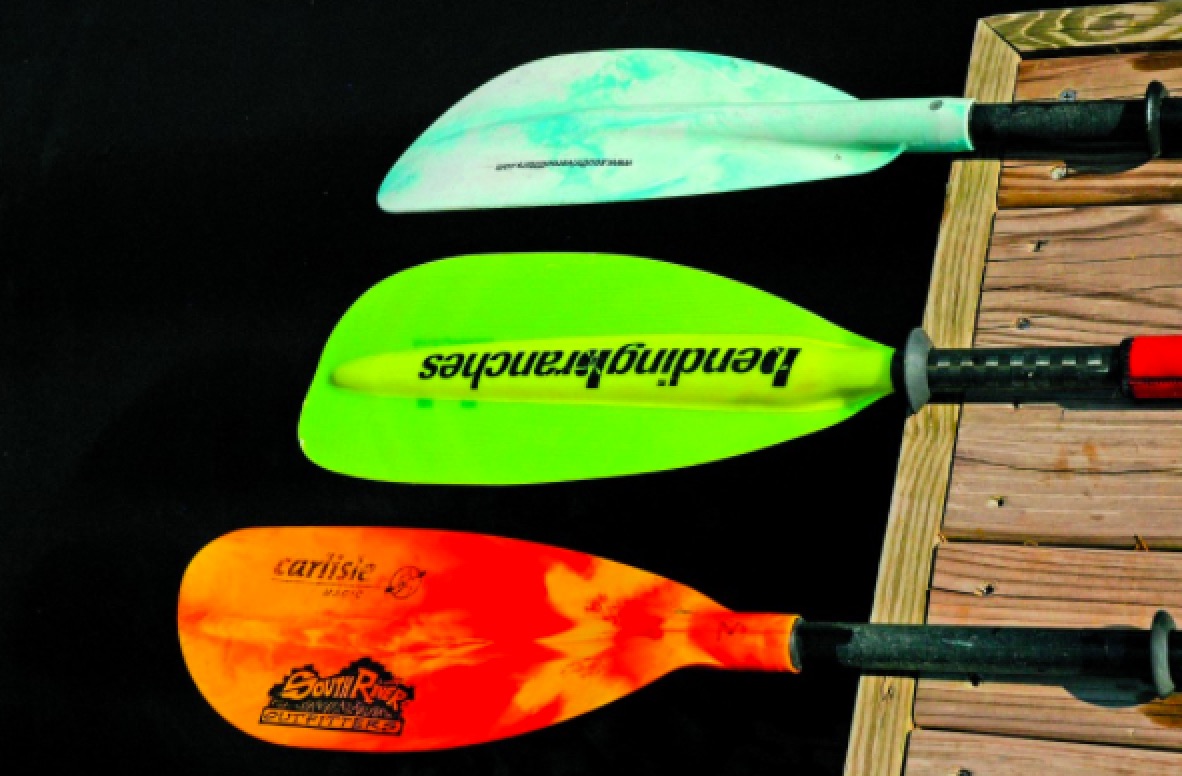
As I referred to before about runners wearing bright colors, it can also be a smart idea to wear a bright colored shirt on your kayak if your paddle and/or kayak is a dark color that is hard to be seen from a distance.
First Aid
Being restricted on space inside of a kayak can be a sticky situation, literally.
Here are just a few ways that first aid attention might rear it’s head while you are in the small space of your kayak.
- When you bring a fish onboard, you now have teeth, spines, and hooks flopping around near your legs and lap (I’ve seen a fish cause some serious damage when it comes on board a kayak!)
- You may also misplace a hook or lure that ends up in your seat (or somewhere that will eventually end up in your skin).
- When wading outside of your kayak, you could possibly trip and your hand, knee, or any body part can land on shells, rocks, debris, etc.
The possibilities are endless of acquiring some type of cut, scrape, or abrasion while kayak fishing.
And saltwater can be prone to carrying bacteria that can cause infections so you don’t want to be able to clean up any cuts quickly.
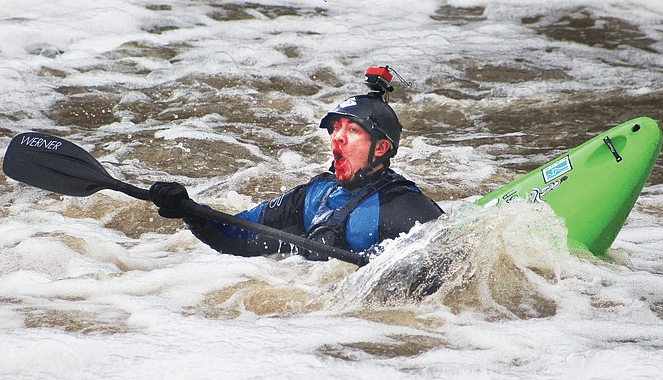
There are no doctors nearby so it is very important to have some type of small first aid kit available to patch yourself up in the meantime.
These kayak first aid kits can be purchased as a complete kit, or you can just make your own and keep in a ziplock bag.
At a minimum, you will want to at least have the following items in your kayak first aid kit:
- Band-aids (small, medium, large)
- Waterproof Tape
- Antibiotic Ointment / Alcohol Wipes (to disinfect)
- Pain Relievers (Tylenol, Aleve, Advil, etc.)
If you happen to get stuck really good by a fish spine, and the pain is throbbing and lasts for a while, get yourself off the water and seek medical attention immediately.
Getting one more cast in isn’t worth the risk of infection.
Handheld Radios
Cell phones are only useful when they are charged, have service, and you have emergency contacts readily available.
In most remote areas that we can fish in our kayaks, cell phone service can be very limited.
The advantage of a radio is that you can quickly communicate with people that are nearby if you are in need of assistance. You also have a direct line to the coast guard.
If you are fishing with a friend that also has a radio, you can easily communicate with them if you lose track of each other.
When looking for a handheld radio to use on your kayak, you are going to want one that floats and that can be submerged (waterproof).
It needs to be able to withstand the elements to be a reliable form of calling for assistance.
Below is the Cobra MR-HH350 Floating Handheld Marine VHF Radio that I carry with me on my fishing trips.

Rain Gear
When you are in a kayak, you are likely to get wet.
You will experience splash coming off of your paddle, waves can often splash water onto you, and fish will also splash you as you try to get them onboard.
So even in the cooler months where it may be sunny out, rain gear comes in handy to keep any excess water off of you. It also helps act as a wind blocker on those breezy days to help keep you warm.
Aside from those extra circumstances in which rain gear is helpful, there is the obvious purpose for it – Keeping yourself dry during a storm or rain shower.
Even in the warmer months, after a storm comes through it may still be cloudy afterward.
The air temperature may also fall a bit. This can cause you to be very uncomfortable and cold if you are caught without rain gear and end up getting soaked.
It is wise to always bring rain gear with you, no matter what the weather forecast may call for.
As we all know too well here in Florida, storms can pop up out of nowhere.
Are you making one of these six mistakes when it comes to inshore fishing from your kayak?
Click here to take the 60-second Kayak Skunk Factor Survey and find out.
Trip Plan
A trip plan should always be left with someone (wife, husband, parents, etc.) before you leave on your kayak fishing trip.
Your kayak trip plan would include the following:
- Where You Are Going
- What Time You Will Be Going
- What Time You Should Be Expected Back
- Names/Numbers of Anyone You May Be Going With
If anything changes during the course of the day, be sure to let this person know that your plans have changed.
If the location you are going to doesn’t have an exact address, it would be wise to print out a satellite image of the area and pinpoint the location that you will be at. On the back of this printout you can write all of the other necessary information given above.
USCG Operation Paddle Smart
Lastly, I would like to point out something very important that many kayakers may be unaware of.
There are many instances in which a kayak is found adrift either offshore, in rivers, lakes, etc. An unmanned vessel raises a red flag to local law enforcement and the coast guard. This can initiate a huge search and rescue mission which puts their lives at stake and also costs a lot of money to do.
How can this be avoided?
The United States Coast Guard put together a program called Operation Paddle Smart, which helps make paddlers more aware of safety on the water.
By simply getting yourself a Paddle Smart Identification Sticker to place on your kayak, you will make it a whole lot easier for authorities to identify who the vessel belongs to.
This can greatly reduce wasting valuable resources for search and rescue.
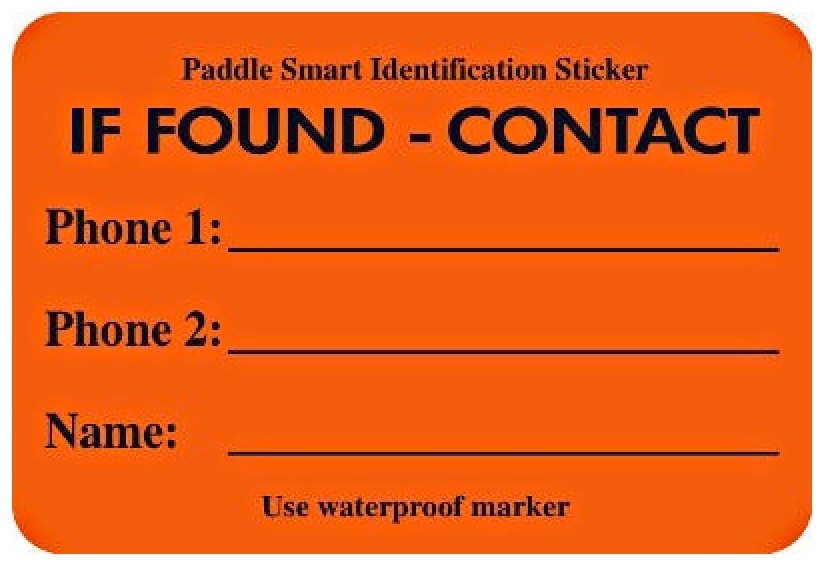
This gives authorities a way to contact you or someone close to you to check whether or not you are safe if your kayak is found floating unoccupied.
9 times out of 10 the kayak just became loose and drifted away from a dock or boat, and the owner is home on the couch watching tv while helicopters and boats are out searching for them.
On this sticker, be sure to put your name, your phone number, and an emergency contact phone number.
To acquire one of these stickers, locate a Coast Guard Auxiliary Unit near you by using the provided link below.
http://www.cgaux.org/units.php
*You can also just write your contact information on the hull of your kayak using waterproof ink.
Conclusion
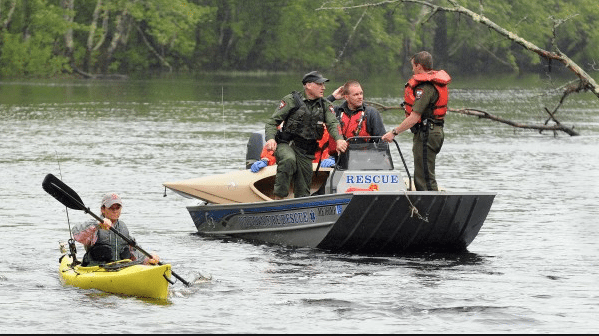
No matter how safe you are, if you spend enough time on a kayak, accidents will happen.
As an avid kayak fisherman, I can’t tell you how many close calls I’ve had with hooks getting caught on me, fish jumping in the kayak and causing havoc, to being flipped out of the kayak (on multiple instances).
But I can tell you that in every instance I was grateful that I had all of the necessary kayak safety items.
ALWAYS wear your life jacket and ALWAYS carry a small first aid kit.
You never know, you might even need it to help someone else that didn’t think ahead.
Please let me know if I left off any critical kayak safety tips, and thanks for reading.
Related Kayak Posts:
- How To Get Back In Your Kayak After It Flips Over In Deep Water (see it here now)
- 11 Essential Kayak Fishing Tips For Newbies (see it here now)
- How To Handle An Emergency While Out On The Water (see it here now)
- How To Stand Up In A Kayak The Simple Way (see it here now)
Are you making one of these six mistakes when it comes to inshore fishing from your kayak?
Click here to take the 60-second Kayak Skunk Factor Survey and find out.
P.S. – If you think any of your kayak friends or networks would benefit from seeing this, please Tag them or Share this with them. Thank you!
Related categories:
STOP WASTING TIME ON THE WATER!
Do what the “SMART ANGLERS” are doing and join the Insider Club.
Here’s what you’ll receive today when you join:
- Weekly fishing reports and TRENDS revealing exactly where you should fish every trip
- Weekly “spot dissection” videos that walk you through all the best spots in your area
- Exclusive fishing tips from the PROS you can’t find anywhere else
- Everything you need to start catching fish more consistently (regardless if you fish out of a boat, kayak, or land).

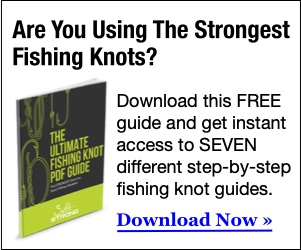







It got me when you said that I need to have a bright red flag while kayaking so that other people with larger boats will see me immediately and avoid me. I will be sure to have one like this because I am a beginner at kayaking. In case a boat comes rushing to me, I might not be able to respond in time to take myself to safety, so I have to do everything I can to avoid this.
Hello, all great tips. Anybody has experience in kayaking with people that suffer from seizures? I want to start kayaking with my son who was diagnosed with seizures two years ago. He takes medicine and it has been under control ever since but I want to take all the precautions.
I am thinking of a sit in kayak, stable and with the deck high enough to cover above his waist to prevent him from going in the water in the event of a seizure. He is 4”10 and 90 lbs. thanks
So many things here I hadn’t thought of. I am new to kayaking but want to start with my daughters this summer. Thank you for writing this!
It’s interesting that you mention how important a trip plan is. I didn’t realize that having a plan of where you’re going, what time you’ll be back, etc. would be helpful to ensure everyone’s safety. It makes sense that a plan like this could help make sure everyone makes it safely and to let others know if something goes wrong. Thanks for the post! http://www.boisearmynavy.com/rafting-and-kayaking
That’s a great point you make about how important it is to make sure that your life jackets are working properly before you’re out in the water. I’ve heard that the life jacket should be snug, but allow you to breathe normally while kayaking. I’ll be sure to remember these great safety tips the next time I take my family out to kayak.
Thanks for the tips on kayaking safely! My wife and I are planning on starting to kayak this summer, and we want to ensure we are safe at all times. Thanks for mentioning to get a bright colored kayak and paddles so you can be more visible. We will make sure we do this. https://www.virginkayaktours.com/bioluminescent-bay-tour.html
How can you be sure that an inflatable PFD will inflate when needed
Good article on safety! Always think safety FIRST. My personal additions:
1. pre-trip planning: check updated marine/weather forecasts water/weather/wind conditions.
2. appropriate attire for conditions, including protective footwear: out of the kayak (intentionally or otherwise) where oysters, sting rays, etc. may be present?
3. protection from the sun
4. adequate supply of fluids for hydration/rehydration: dehydration can be dangerous.
5. energy/nutrition: if “caught” in an unexpected circumstance that requires extraordinary expense of energy, having along even a small quantity of concentrated, high-energy bar/snack can be useful.
Also…
– I waterproof stow in my yak some form of I.D. I also keep a waterproof form of I.D. on my person at all times. In addition to wearing a whistle on a lanyard around my neck I keep my vehicle key on the same lanyard. I keep a sharp knife on my person at all times.
Excellent additions Richard! Thanks for taking time to read and add more value to the post.